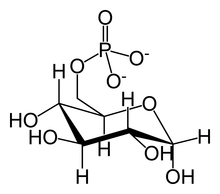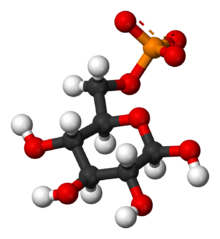
Back غلوكوز 6-فوسفات Arabic قلوکز ۶-فوسفات AZB Глюкозо-6-фосфат Bulgarian Glukoza 6-fosfat BS 6-Fosfat de glucosa Catalan Glukóza-6-fosfát Czech Glucose-6-phosphat German Glucosa-6-fosfato Spanish Glükoos-6-fosfaat Estonian گلوکز ۶-فسفات Persian
 | |
 | |
| Names | |
|---|---|
| IUPAC names
D-Glucopyranose 6-phosphate
6-O-Phosphono-D-glucopyranose | |
| Identifiers | |
3D model (JSmol)
|
|
| ChEBI | |
| ChemSpider | |
| KEGG | |
| MeSH | Glucose-6-phosphate |
PubChem CID
|
|
| UNII | |
| |
| |
| Properties | |
| C6H13O9P | |
| Molar mass | 260.136 |
Except where otherwise noted, data are given for materials in their standard state (at 25 °C [77 °F], 100 kPa).
| |
Glucose 6-phosphate (G6P, sometimes called the Robison ester) is a glucose sugar phosphorylated at the hydroxy group on carbon 6. This dianion is very common in cells as the majority of glucose entering a cell will become phosphorylated in this way.
Because of its prominent position in cellular chemistry, glucose 6-phosphate has many possible fates within the cell. It lies at the start of two major metabolic pathways: glycolysis and the pentose phosphate pathway.
In addition to these two metabolic pathways, glucose 6-phosphate may also be converted to glycogen or starch for storage. This storage is in the liver and muscles in the form of glycogen for most multicellular animals, and in intracellular starch or glycogen granules for most other organisms.